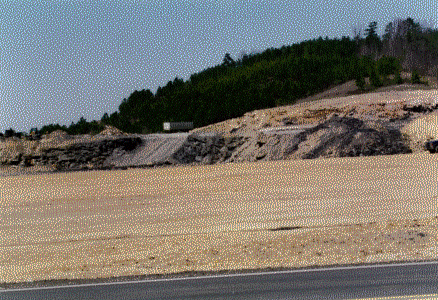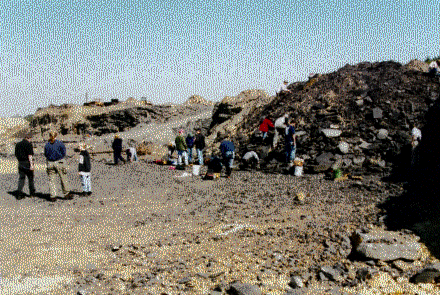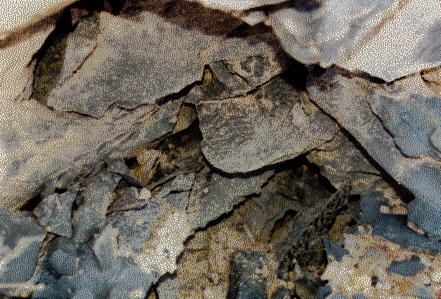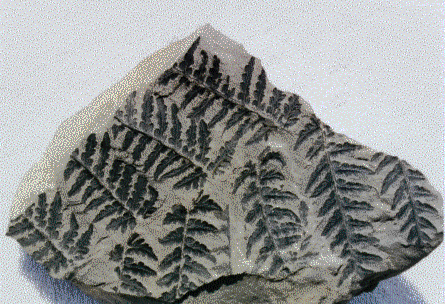07_08_cl_stigmaria461
Stigmaria, the root system of a lycopod such as Lepidodendron or Sigillaria.
Stigmaria, the root system of a lycopod such as Lepidodendron or Sigillaria.
Department of Physics and Astronomy
University of Alabama
Tuscaloosa, Alabama
The field trip on March 27, 1999 was the second organized BPS trip to a construction site near Warrior. The trip was attended by about 25 people, mainly from Birmingham, Huntsville, Tuscaloosa, the Florence area, and the University of North Alabama. Attendees included BPS members, guests, children, professors, and students, and the day was sunny, clear, and warm.
 |
|
 |
Fossil hunters at the main rock pile where Lepidodendron and Sigillaria specimens were abundant. |
|---|
The site was first identified as being a source of Carboniferous-period plant fossils by BPS member Gerry Badger, and the first BPS field trip to the site took place on November 15, 1997. Although various BPS members and probably others have visited the site at various times during the past year, the site has changed so much that on March 27, the site was better than it had ever been before as far as numbers and quality of plant fossils are concerned.
The most abundant plant fossils found during our most recent visit were bark impressions of the giant arborescent lycopods Lepidodendron and Sigillaria. These were mainly found in rock piles around the area of a northeast wall of rock. Large slabs showed the familiar Lepidodendron leaf scars, which look like fish scales. In many cases the scars were clear and well-defined, making the specimens extremely beautiful examples. On close inspection, the leaf scars show characteristic bundle and parichnos scars representing leaf attachment points, and many of the pieces are probably of the same species. However, after checking various books I have not yet identified the exact species at Warrior. It is clear also that more than one species of Lepidodendron is present at this site. It is also interesting that specimens of Lepidodendron at Warrior came in both direct and inverse impressions. In direct impressions, the leaf scars are raised, and are more like molds of the original object. In most pieces, however, the leaf scars are simply inverse impressions of the original raised scars, and therefore appear as depressions in the fossil.
The Sigillaria specimens are more abundant now at this site than they were on November 15, 1997. They are characterized by parallel bands of leaf scars distinctly different from the spirally arranged scars seen on Lepidodendron, although a spiral arrangement may still be present. Several species were found, but I have not been able to make exact identifications. Sigillaria specimens attendees found included not only outer bark impressions, where the leaf scars are roundish and almost overlapping, but also beautiful decorticated impressions, direct and inverse, where only parichnos scars are seen either as small spots or close pairs of small spots. These are as known as Syringodendron. The decorticated specimens are cases where the outer bark is gone, so they represent an inner bark layer. |
||
Also abundant at this site, but not necessarily found in the rock piles, were several types of seed ferns characteristic of the period. These were found at a specific level of the east rock wall less than a foot above the ground level and about 20 feet from the rock piles. The ferns found included beautiful examples of Eusphenopteris, Mariopteris, Neuropteris, and Alethopteris form genera, but I have not yet determined exact species. Because many of these were found in situ, they were still beautifully preserved with dark carbonaceous remains of the original plant material and fine details of vein systems in individual pinnules. Several attendees spent much of their time searching for ferns at the rock wall, and many were found. According to Dave Kopaska-Merkel, one young person, whose first name was Jonathan, split a large slab and found some very nice large ferns inside. Although I am not aware of any examples found during this trip, the site also is known for having Lyginopteris ferns which are distinctly different from the others. Several different species of Sphenopteris ferns have also been found in the past.
 |
View of rock wall on east side of site where ferns were found in situ. |
|---|
 |
Typical example of a set of ferns extracted from the above part of the wall. |
|---|
Fossils of the well-known horsetail, Calamites, have also been found in abundance at this site. Several attendees (including myself) found three-dimensional Calamites stems further down the same rock wall where the ferns were found. Dave Kopaska-Merkel found a nearly foot-long Calamites specimen embedded in a larger rock. Also found were excellent specimens of the foliage of Calamites, including a fine small piece of (probable) Asterophyllites equisetiformis shown to me by Gerry Badger. At least three different species of Asterophyllites have been found at this site.
|
There were a few interesting highlights from the trip. Wayne Canis, several of his students from the University of North Alabama, and guest Richard Keyes of Huntsville, found a large and extremely beautiful example of a lycopod root system, Stigmaria, with dozens of root impressions emanating from the sides and clear deep small depressions or root scars on the main body, known as a rhizophore. The fossil was so fragile that Richard went off site to buy a can of spray glue to insure the piece would hold together during the drive home. Also found today were large fossil "stumps" and logs of arborescent lycopod stems. Gerry Badger located a 64 pound stump in the one of the upper rock piles at the site, and Wayne Canis and one of his students each found a similar piece. Particularly interesting was a long, nearly vertically-standing log found in an upper rock wall near the back of the site. Except for the log, no other fossils were obvious in this wall. Gerry Badger heroically tried to get the main body of the log off with a hammer. This
was at great risk since the specimen was under a large rock overhang! The job was not easy and afterward I saw the specimen in pieces in the back of Gerry's car, but he still was upbeat about it.Later, I found another stump fossil in a rock wall on the north side of the main site level. It, too, was the only fossil noticed in that particular area, although several of us thought we saw the end of a highly flattened stump still in the wall but much higher up in the same area. The stump I found is about a foot long and weighs 77 pounds. Unlike the others found, it is covered with hundreds of small scars and impressions, indicating a fairly definite identification as an arborescent lycopod cast. These "stumps" and logs represent cases where a hollow cavity left by the stem was filled with mud which later solidified and preserved the general shape as well as any inner details. They are not "petrified" in the usual sense.
In summary, this field trip was a very enjoyable experience for all who attended. On a wonderful day, we all experienced a part of Alabama's past and took home the beautiful relics of a bygone era of Alabama natural history. |
||||||
 |
Group working on Stigmaria fossil near road to upper level of site. |
|---|